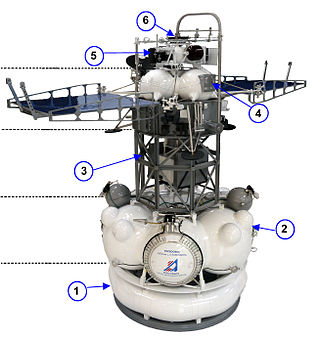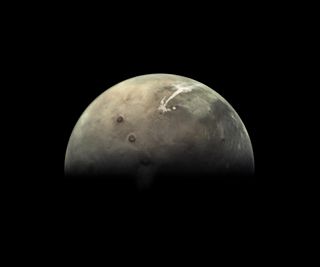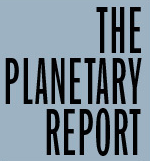
Atlas is an inner satellite of Saturn which was discovered by Richard Terrile in 1980 from Voyager photos and was designated S/1980 S 28. In 1983 it was officially named after Atlas of Greek mythology, because it "holds the rings on its shoulders" like the Titan Atlas held the sky up above the Earth. It is also designated Saturn XV.

The Planetary Society is an American internationally-active non-governmental nonprofit organization. It is involved in research, public outreach, and political space advocacy for engineering projects related to astronomy, planetary science, and space exploration. It was founded in 1980 by Carl Sagan, Bruce Murray, and Louis Friedman, and has about 60,000 members from more than 100 countries around the world.

Tempel 1 is a periodic Jupiter-family comet discovered by Wilhelm Tempel in 1867. It completes an orbit of the Sun every 5.6 years. Tempel 1 was the target of the Deep Impact space mission, which photographed a deliberate high-speed impact upon the comet in 2005. It was re-visited by the Stardust spacecraft on February 14, 2011, and came back to perihelion in August 2016. On 26 May 2024, it will make a modest approach of 0.55 AU to Jupiter which will lift the perihelion distance and 9P will next come to perihelion on 12 February 2028 when it will be 1.77 AU from the Sun.
Paul D. Spudis (1952–2018) was an American geologist and lunar scientist. His specialty was the study of volcanism and impact processes on the planets, including Mercury and Mars.
Universe Today (U.T.) is a North American-based non-commercial space and astronomy news website. The domain was registered on December 30, 1998, and the website went live in March 1999, founded by Canadian Fraser Cain. The Universe Today assumed its current form on July 24, 2003, featuring astronomy news and space-related issues.
A flag of Mars is a concept of a possible flag design, meant to symbolize the planet Mars or to represent a fictional Martian government, in works of fiction.

The Living Interplanetary Flight Experiment was an interplanetary mission developed by the Planetary Society. It consisted of sending selected microorganisms on a three-year interplanetary round-trip in a small capsule aboard the Russian Fobos-Grunt spacecraft in 2011, which was a failed sample-return mission to the Martian moon Phobos. The Fobos-Grunt mission failed to leave Earth orbit and was destroyed.

Chang'e 2 is a Chinese uncrewed lunar probe that was launched on 1 October 2010. It was a follow-up to the Chang'e 1 lunar probe, which was launched in 2007. Chang'e 2 was part of the first phase of the Chinese Lunar Exploration Program, and conducted research from a 100-km-high lunar orbit in preparation for the December 2013 soft landing by the Chang'e 3 lander and rover. Chang'e 2 was similar in design to Chang'e 1, although it featured some technical improvements, including a more advanced onboard camera. Like its predecessor, the probe was named after Chang'e, an ancient Chinese moon goddess.

Endeavour is an impact crater located in the Meridiani Planum extraterrestrial plain within the Margaritifer Sinus quadrangle (MC-19) region of the planet Mars. Endeavour is about 22 kilometers (14 mi) in diameter. Using Mars Reconnaissance Orbiter data, phyllosilicate-bearing outcrops have been detected along its rim. These minerals may have formed under wet conditions in a low-acidic environment during the early history of Mars. There are raised rim segments to the north, east, and southwest. The rim has become worn, rounded and degraded, with infilling of plains material in a manner similar to the Victoria crater.

Yinghuo-1 was a Chinese Mars-exploration space probe, intended to be the first Chinese planetary space probe and the first Chinese spacecraft to orbit Mars. It was launched from Baikonur Cosmodrome, Kazakhstan, on 8 November 2011, along with the Russian Fobos-Grunt sample return spacecraft, which was intended to visit Mars' moon Phobos. The 115-kg (250-lb) Yinghuo-1 probe was intended by the CNSA to orbit Mars for about two years, studying the planet's surface, atmosphere, ionosphere and magnetic field. Shortly after launch, Fobos-Grunt was expected to perform two burns to depart Earth orbit bound for Mars. However, these burns did not take place, leaving both probes stranded in orbit. On 17 November 2011, CNSA reported that Yinghuo-1 had been declared lost. After a period of orbital decay, Yinghuo-1 and Fobos-Grunt underwent destructive re-entry on 15 January 2012, finally disintegrating over the Pacific Ocean.

Astronomy & Geophysics (A&G) is a scientific journal and trade magazine published on behalf of the Royal Astronomical Society (RAS) by Oxford University Press. It is distributed bimonthly to members of the RAS.
The Jonathan Eberhart Planetary Sciences Journalism Award was established by the Division for Planetary Sciences to recognize and stimulate distinguished popular writing on planetary sciences. The winning author receives a prize of $1,000, plus a citation. The award is named after science journalist Jonathan Eberhart.
Darius Lakdawalla is an economist. He is the Quintiles Chair in Pharmaceutical Development and Regulatory Innovation at the School of Pharmacy at the Leonard D. Schaeffer Center for Health Policy and Economics at the University of Southern California and co-founder and Chief Scientific Officer of Precision Health Economics, a health care consulting firm. Dr. Lakdawalla also serves as the Executive Director of the "Innovation and Value Initiative" (IVI), a multi-stakeholder scientific initiative that aims to improve the way value is measured and rewarded in the healthcare marketplace.

Yutu was a robotic lunar rover that formed part of the Chinese Chang'e 3 mission to the Moon. It was launched at 17:30 UTC on 1 December 2013, and reached the Moon's surface on 14 December 2013. The mission marks the first soft landing on the Moon since 1976 and the first rover to operate there since the Soviet Lunokhod 2 ceased operations on 11 May 1973.

Emily Stewart Lakdawalla is an American planetary geologist and former Senior Editor of The Planetary Society, contributing as both a science writer and a blogger. She has also worked as a teacher and as an environmental consultant. She has performed research work in geology, Mars topography, and science communication and education. Lakdawalla is a science advocate on various social media platforms, interacting with space professionals and enthusiasts on Facebook, Google+ and Twitter. She has appeared on such media outlets as NPR, BBC and BBC America.

The Visual Monitoring Camera (VMC), also known as the Video Monitoring Camera and Mars Webcam, is a small camera mounted on Mars Express spacecraft. It is operated by the Mars Express Flight Control Team at ESOC in Darmstadt, Germany. Originally, VMC was a technical camera to monitor the separation of the Beagle 2 lander, but after a few years, it was repurposed into Mars Webcam, streaming its data to the web and even being used for science.
Life Investigation For Enceladus (LIFE) was a proposed astrobiology mission concept that would capture icy particles from Saturn's moon Enceladus and return them to Earth, where they could be studied in detail for signs of life such as biomolecules.
Robert P. King, born August 9, 1953, is an American photographer, writer, and an amateur astronomer. He publishes an astronomy blog called Astro Bob which is "widely read and respected" according to astronomer Bob Mizon.
Susan Niebur (1973–2012) was an American planetary scientist, promoter of women in science, and mommyblogger.











